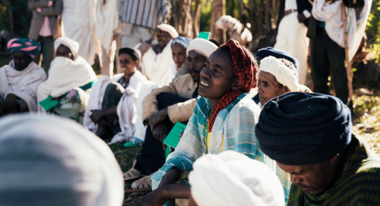Crisis as opportunity: Can the rural exodus of young people in Africa be stopped?
Promises of investment and modernization for agricultural transformation can reduce the exodus of young people from rural areas. But they must not turn out to be illusions.

While urbanization in Western economies and large parts of Latin America and Asia is already well advanced and the majority of the population lives in cities, this proportion is currently still around 43 percent in Africa, albeit increasing rapidly. The process of migration is not a new phenomenon in Africa's rural areas, in fact, it is an important strategy to improve livelihoods, especially for individuals and groups in a precarious situation. Moving to large cities is just one of many options. Temporary migration and households with multiple bases are also widespread.
The background to this are individual considerations such as the desire to improve living conditions, but also fundamental changes in ecological, socio-cultural or economic conditions – for instance, environmental degradation, changing value-systems or income prospects. These can also trigger larger migratory processes. While the trend in Africa, as in many parts of the world, is towards urban living, these movements often do not target the foremost urban centres of the respective countries, but focus on smaller cities in closer proximity to the rural population.
Unlike in Europe at the time of industrialization, for example, the growing population in many African cities does not find employment in a correspondingly growing secondary and later tertiary sector. Instead, many people in the cities live and work in informal and precarious circumstances. This is also problematic insofar as family members who have remained in rural areas are often dependent to a considerable extent on the incomes of those that have migrated to the cities. As a result, some of the people who have left return to rural areas.
Why stay?
But what prospects are there for a growing population if they stay in rural areas? In the long term, significant employment opportunities for the rural population will most likely be outside of agriculture. At present, however, especially in peripheral rural areas, there are only basic artisan-based businesses and services (with the possible exception of tourism). This means that agriculture and related economic sectors, such as trade in agricultural products, will remain the main source of support for large parts of the rural population for the foreseeable future.

Agriculture itself is often characterized by a strong focus on subsistence, low income prospects and hard physical work, which deters younger people in particular. Currently, however, a new dynamic seems possible that could give agriculture in Africa a boost and make it attractive once again for younger people who might otherwise consider leaving.
Agricultural transformation in times of crisis
The current situation of agriculture is characterized by a global crisis, marked, among other things, by fluctuating or rising prices for agricultural input products and, in some cases, uncertain food supplies in the context of global food value chains. These problems often also pose challenges for people in rural areas of Africa and their livelihoods.
However, they also mean that many national governments as well as international investors once again view agriculture as a crucial sector of the economy in which they are investing. For example, some countries are currently implementing programs to promote food security (e.g. as part of the African Union's Comprehensive African Agricultural Development Programme (CAADP)), which are intended to support domestic agriculture.
At the same time, digital modernization of agriculture is taking place in Africa as well, where as a first step simple solutions significantly improve the lot of farmers, including digital self-help groups (e.g. for sharing knowledge on methods of cultivation or dealing with pests), digital payment systems and digital platforms for purchasing input products and selling their own produce. Other new technologies are also finding their way into African agriculture, for instance in the field of sensor technology.
Unfortunately, in the past, such promises of investment and modernization often turned out to be false and only benefited a few domestic or foreign players, if at all. The question therefore arises: What can be done so that these measures actually benefit the rural population?
Farming as a business
For young people in particular, it is important that agriculture generates an adequate income, but also offers additional opportunities and is not perceived as "archaic drudgery". Small-scale, subsistence farming – often romanticized in Europe – is not what many young people in Africa see as their future. A business that generates income and growth is much more attractive. The development of farmers into independent business people with solid agricultural and business management training and access to a basic set of modern technologies and financial support can be of help, as can further education.
However, universities in the big cities often have the disadvantage that even in agricultural science courses training is too far removed from practice. Graduates who have spent time in the city often look for a career there and do not return to rural areas. Strengthening rural and small-town practice-oriented educational institutions in cooperation with local practitioners can offer an alternative. Even in terms of financial support and technology transfer, local and comprehensive partnerships with the integration of local knowledge are important, as is access to international networks and expertise. In addition to technology transfer, empowerment is an important factor. This can be done, for example, by establishing special interest associations, self-help groups and market-oriented groups, setting up networks, mentoring partnerships and management training.
Creating opportunities
Two initiatives on very different scales are used here as examples to illustrate how agriculture-oriented development efforts can open up opportunities for young people in rural areas:
The ACADES Youth Famers Association is a bottom-up initiative originally founded by Malawian university graduates, which is now financially supported by the Malawian government and the World Bank. ACADES invests in young people and smallholder farmers with the aim of creating attractive living and income opportunities in the agricultural sector. The focus is on increasing and modernizing the means of production. Typical measures include the provision of tools and financial resources, the development of storage capacities and seed production as well as comprehensive training and help for self-help, particularly in organized groups.
The latter are supported in particular with joint savings and investment measures as well as joint access to commercial markets, which ideally would give them increased bargaining power. The initiative also includes specific support for women. In recent years, ACADES has mobilised over 20’000 small-scale farmers, provided over 7000 farmers with financial resources, facilitated market access for over 12’000 farmers and trained over 14’000 farmers.
The GIZ (Deutsche Gesellschaft für Internationale Zusammenarbeit – German Corporation for International Cooperation) supports a modern agricultural sector as an opportunity for young Africans to build an attractive livelihood in rural areas – and to not have to leave. GIZ addresses this in its global project "Promoting employment for young people in rural areas". In various projects (including in Kenya, Burkina Faso and Mozambique), education and training, access to funding, networking with other businesses (e.g. in cooperatives), improving market access, access to land rights, access to technical equipment and gender-specific promotion (empowerment) are seen as key levers that should be supported jointly wherever possible.
Here, too, the aim is to move away from subsistence agriculture towards modern business models, even beyond the confines of the agricultural sector. Accordingly, the GIZ projects also aim to create jobs in the areas of agricultural input products, services, processing, distribution, marketing and retail. As part of this and similar projects, GIZ and other partners trained or instructed over two million people in Africa between 2009 and 2020 and created around 850’000 jobs.
It is important not to ignore problem areas. The modernization of agriculture can lead to the replacement of labour, as was the case in the course of mechanization in Germany. Structural impediments in agriculture, which often posed problems in past modernization and commercialization efforts, also remain unresolved in many cases. These include, for example, ownership and usage rights of seeds and of digital data or highly regulated relationships between producers and buyers in commercial value chains. The intensification of agriculture can also come into conflict with ecological sustainability. Transparent, democratic and (scientifically) evaluated processes are therefore important.
Conclusion
Many of the approaches described here are neither new nor free of risks. However, in the current crisis, new methods of financial and wider-ranging support, new bottom-up initiatives and the new possibilities of digitalization bear great potential in creating career opportunities in the agricultural sector for the young population and thus to retain them in rural areas.





